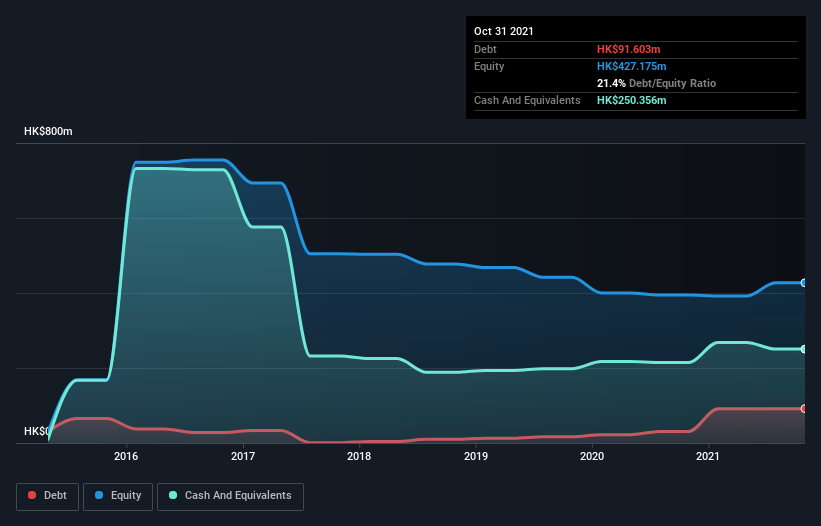David Iben put it well when he said, 'Volatility is not a risk we care about. What we care about is avoiding the permanent loss of capital.' So it might be obvious that you need to consider debt, when you think about how risky any given stock is, because too much debt can sink a company. We note that QPL International Holdings Limited (HKG:243) does have debt on its balance sheet. But should shareholders be worried about its use of debt?
When Is Debt A Problem?
Debt assists a business until the business has trouble paying it off, either with new capital or with free cash flow. Part and parcel of capitalism is the process of 'creative destruction' where failed businesses are mercilessly liquidated by their bankers. However, a more frequent (but still costly) occurrence is where a company must issue shares at bargain-basement prices, permanently diluting shareholders, just to shore up its balance sheet. Of course, debt can be an important tool in businesses, particularly capital heavy businesses. When we think about a company's use of debt, we first look at cash and debt together.
Check out our latest analysis for QPL International Holdings
What Is QPL International Holdings's Net Debt?
You can click the graphic below for the historical numbers, but it shows that as of October 2021 QPL International Holdings had HK$91.6m of debt, an increase on HK$30.8m, over one year. But it also has HK$250.4m in cash to offset that, meaning it has HK$158.8m net cash.

A Look At QPL International Holdings' Liabilities
We can see from the most recent balance sheet that QPL International Holdings had liabilities of HK$203.0m falling due within a year, and liabilities of HK$18.1m due beyond that. Offsetting this, it had HK$250.4m in cash and HK$159.5m in receivables that were due within 12 months. So it can boast HK$188.7m more liquid assets than total liabilities.
This surplus liquidity suggests that QPL International Holdings' balance sheet could take a hit just as well as Homer Simpson's head can take a punch. Having regard to this fact, we think its balance sheet is as strong as an ox. Simply put, the fact that QPL International Holdings has more cash than debt is arguably a good indication that it can manage its debt safely. The balance sheet is clearly the area to focus on when you are analysing debt. But it is QPL International Holdings's earnings that will influence how the balance sheet holds up in the future. So if you're keen to discover more about its earnings, it might be worth checking out this graph of its long term earnings trend.
In the last year QPL International Holdings wasn't profitable at an EBIT level, but managed to grow its revenue by 45%, to HK$440m. Shareholders probably have their fingers crossed that it can grow its way to profits.
So How Risky Is QPL International Holdings?
Although QPL International Holdings had an earnings before interest and tax (EBIT) loss over the last twelve months, it made a statutory profit of HK$20m. So taking that on face value, and considering the cash, we don't think its very risky in the near term. We also take heart from the solid 45% revenue growth in 12 months; undoubtedly a good sign. That growth could mean this is one stock well worth watching. When analysing debt levels, the balance sheet is the obvious place to start. However, not all investment risk resides within the balance sheet - far from it. These risks can be hard to spot. Every company has them, and we've spotted 3 warning signs for QPL International Holdings (of which 1 is potentially serious!) you should know about.
If, after all that, you're more interested in a fast growing company with a rock-solid balance sheet, then check out our list of net cash growth stocks without delay.
Valuation is complex, but we're here to simplify it.
Discover if QPL International Holdings might be undervalued or overvalued with our detailed analysis, featuring fair value estimates, potential risks, dividends, insider trades, and its financial condition.
Access Free AnalysisHave feedback on this article? Concerned about the content? Get in touch with us directly. Alternatively, email editorial-team (at) simplywallst.com.
This article by Simply Wall St is general in nature. We provide commentary based on historical data and analyst forecasts only using an unbiased methodology and our articles are not intended to be financial advice. It does not constitute a recommendation to buy or sell any stock, and does not take account of your objectives, or your financial situation. We aim to bring you long-term focused analysis driven by fundamental data. Note that our analysis may not factor in the latest price-sensitive company announcements or qualitative material. Simply Wall St has no position in any stocks mentioned.
About SEHK:243
QPL International Holdings
Manufactures and sells integrated circuit lead frames, heatsinks, stiffeners, and related products in the United States, Hong Kong, Europe, the People's Republic of China, the Philippines, Malaysia, Singapore, and Thailand.
Excellent balance sheet with slight risk.
Market Insights
Community Narratives




